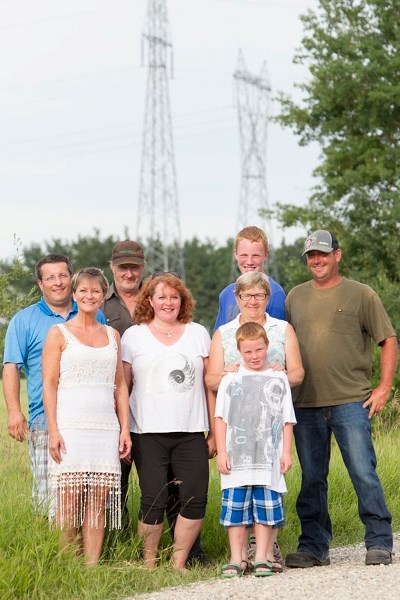A three-year “David against Goliath” battle between a group of Innisfail-area residents and AltaLink over the transmission company's planned $51- million line upgrade and substation has ended in victory for the determined locals.
“Let's call it a victory in the sense we fought David against Goliath, said Ivo Wachter, who lives five kilometres southeast of town and has led a group of 24 nearby families – known as the Wachter Group -- for the past three years against AltaLink's plan. “In our communications with AltaLink it was never malicious. It was a question of principle. We came together as a group and as a neighbourhood and we fought and stood for something that we felt strongly about, and we succeeded.”
Last week, the Alberta Utilities Commission (AUC) released its 113-page decision into AltaLink's application for its planned $322-million Red Deer-area transmission line project, which included the contentious 14-kilometre preferred route in and around Innisfail's south end, as well as the planned Hazelwood substation. AltaLink has maintained the Red Deer-area development was vital to reinforce the reliability of the transmission system throughout Central Alberta, which the company says has gone 30 years without any significant reinforcement during a period of enormous growth in the region.
The decision, released on July 29, approved six of AltaLink's seven transmission reinforcement projects for Red Deer, Sylvan Lake, Ponoka, Didsbury and Innisfail. All the approvals – except Innisfail's – were for AltaLink's preferred routes. The seventh application for a proposed transmission line in the Lacombe area was dropped over placement concerns from Canadian Pacific Railway. AltaLink will have to file a new application that will be subject to a new hearing and decision, said Jim Law, communication director for AUC.
The (AUC) panel, after reviewing extensive submissions into AltaLink's application last March, ruled against the electrical transmission company's preferred route on Innisfail's south side, which was expected to cost $51 million to construct. Instead, the AUC accepted the alternate plan for the line to run north of Innisfail.
“The Commission finds, however, that the town's (development) plans have progressed far enough that weight needs to be given to the potential impacts to the future residences in this area. The Commission further finds that the preferred route will have an impact on the town's development plans, generally,” said the AUC decision, which ultimately ruled that impacts on individual landowners would be similar on both proposed routes. “The Commission finds the town's objection to the preferred route and preference for the alternate to be a significant factor in its decision.”
The AUC decision to go with AltaLink's alternate route comes after stiff opposition from the Wachter Group and the Town of Innisfail. The Wachter Group said the preferred route would have created adverse impacts on drainage, noise, agriculture and health for residents.
“After three years we will now be able to sleep at night without worrying about having a substation placed right beside our farm on the fenceline, 650 metres from our house,” said Ruth Lind, a member of the Wachter Group. “We can now get back on track and plan for the future for generations on our farm without worrying about health, noise and drainage.”
Among the many concerns put forward by the town against the preferred route was that it would adversely affect efforts to create an attractive urban area, add costs and barriers to development in the area and create uncertainty for land development, particularly for future plans in the Woodlands area north of Highway 54 where more than 600 dwelling units are envisioned in the future.
Craig Teal, the town's director of planning and operational services, said AUC's final decision did not note much of a difference in terms of cost and environmental impacts between the two proposed Innisfail-area routes that were on the table.
“They (AUC) said, ‘Look, we think it's a draw.' The commission is saying we don't think there is much difference. We are not accepting your argument,” said Teal, who made a presentation at the AUC application hearings last March. “The town is happy with the outcome of the AUC decision. We did have one other alternative suggestion in terms of using an existing right-of-way, which unfortunately the commission did not agree with.
“But generally in terms of using the alternate route as opposed to the original preferred route identified by AltaLink, the alternate route will have a more manageable impact on the town's future planning efforts,” added Teal.
Meanwhile, reaction from AltaLink over the AUC decision was positive, despite having to move forward with an alternate route in the Innisfail area.
“We are ready, willing and able to build whatever route AUC should choose. In the case of Innisfail we had a preferred route on the south side of town and an alternate route on the north side. Both were absolutely viable routes,” said Scott Schreiner, AltaLink's director of external engagement. “We believed the impact on the south side was slightly lower because it followed road allowance on a greater portion of the route.”
He said the cost of moving forward with the northern alternate route will be “slightly” higher than the estimated $51 million to build the preferred southern route.
Although AltaLink does have the option of filing an appeal against the decision directly to the AUC, as well as to the Alberta Court of Appeal, there are no plans to do so, said Schreiner.
“We are absolutely satisfied with the decision and we will work with the landowners on the alternate route,” said Schreiner. “If we didn't like the route we wouldn't have filed it.”



